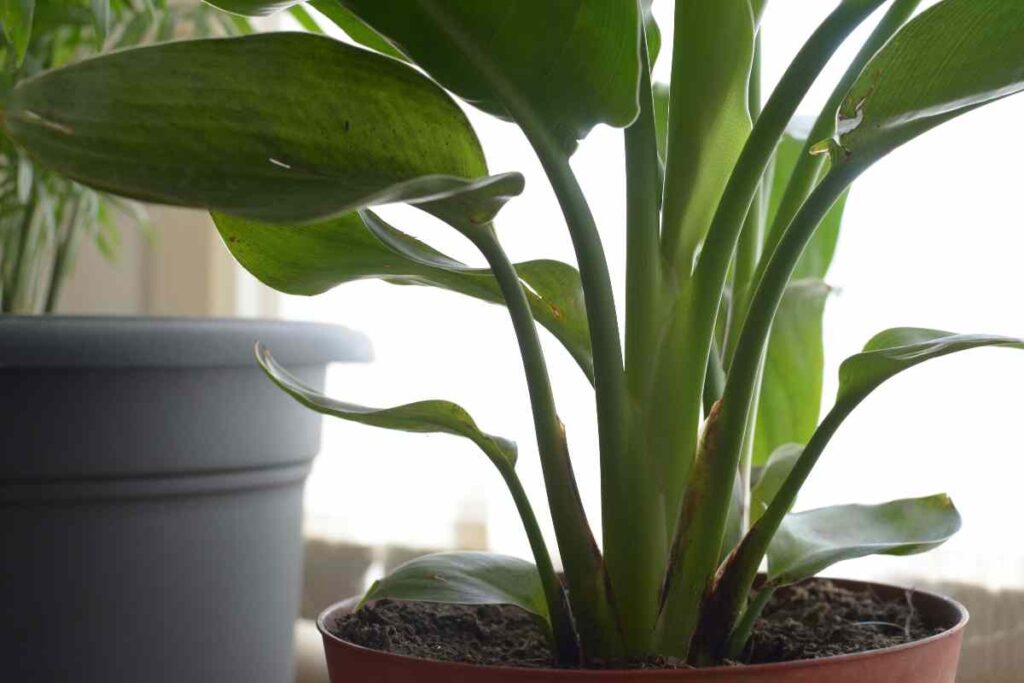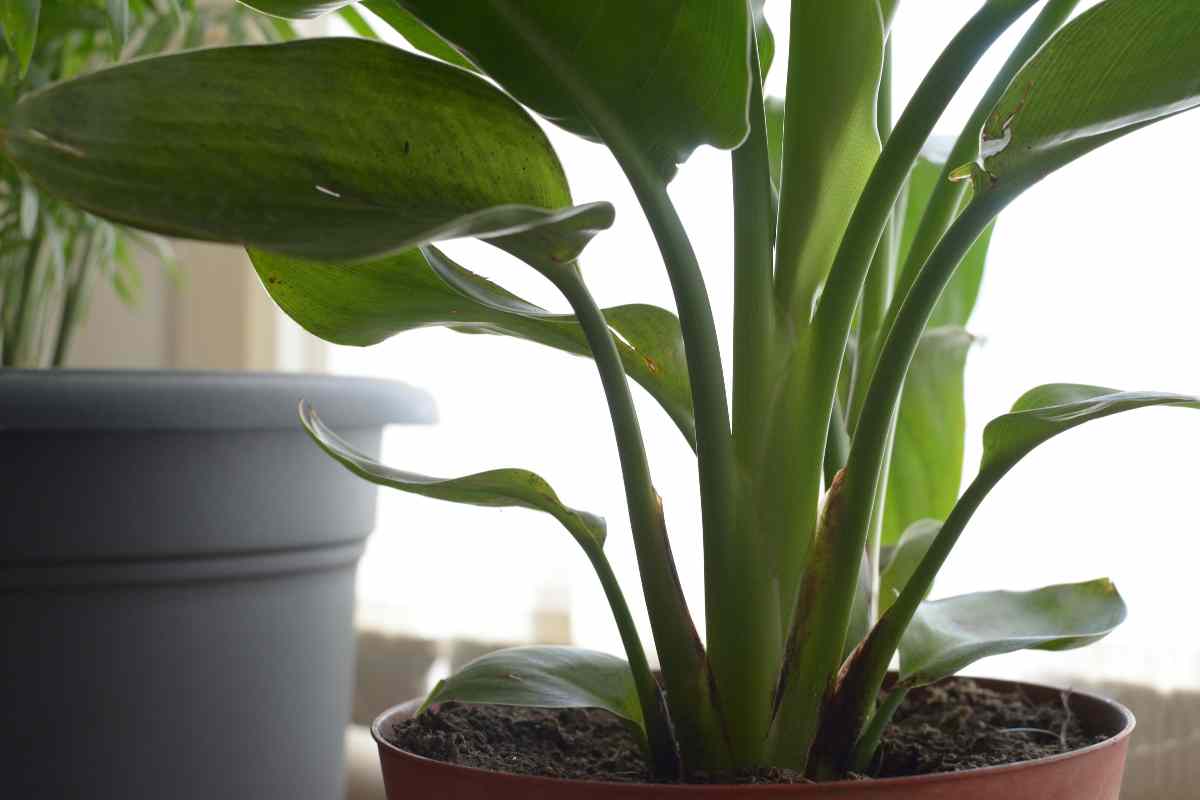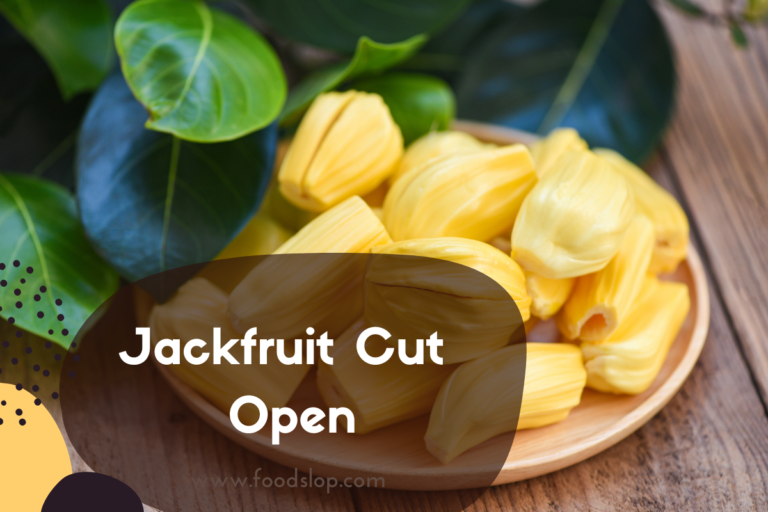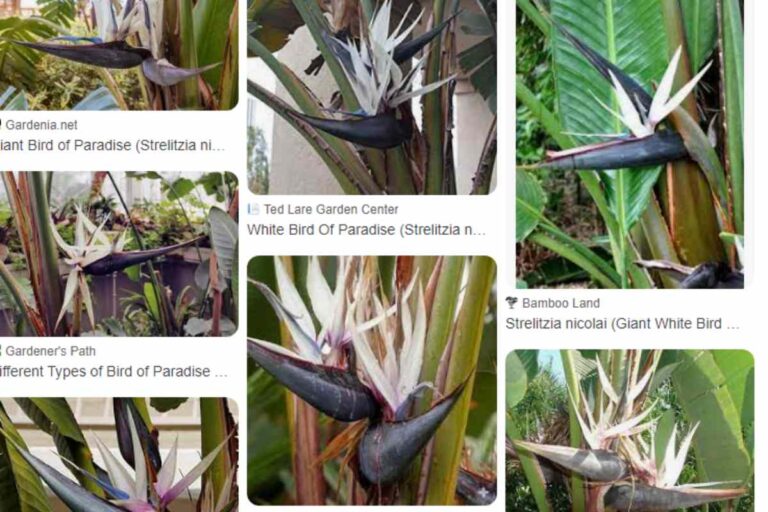Tall Bird Of Paradise Plant
Are you looking to add a touch of exotic beauty to your indoor or outdoor space? Look no further than the tall bird of paradise plant.
With its stunning foliage and vibrant flowers, this plant is sure to make a statement in any setting.
The tall bird of paradise plant, also known as Strelitzia nicolai, is native to South Africa and belongs to the banana family. Its large leaves resemble those of a banana tree, while its unique orange and blue flowers resemble the plumage of tropical birds.
Tall Bird Of Paradise Plant

Caring for this plant is relatively easy, as it thrives in bright sunlight and well-draining soil. Regular watering and occasional fertilization will keep it happy and healthy.
Whether you choose to display it indoors or outdoors, the tall bird of paradise plant will bring a touch of tropical elegance wherever it goes.
Characteristics of the Tall Bird of Paradise Plant
You’ll be amazed by the striking characteristics of the tall bird of paradise plant. This tropical beauty is known for its vibrant foliage and unique flowers, making a statement in any garden or indoor space.
Standing at an impressive height of up to 30 feet, the tall bird of paradise plant features large, banana-like leaves that fan out gracefully. The leaves themselves are a deep green color with bold ribbing, adding to their dramatic appearance.
But what truly sets this plant apart are its stunning flowers. Resembling birds in flight, these bright orange and blue blooms emerge from boat-shaped bracts and create a striking contrast against the lush green foliage.
With its towering stature and eye-catching features, the tall bird of paradise plant is truly a showstopper in any landscape.
Care Requirements for the Tall Bird of Paradise Plant
To care for the Tall Bird of Paradise plant, you need to consider its sunlight and temperature needs. It thrives in bright, indirect sunlight and prefers temperatures between 65-85°F (18-29°C).
When it comes to watering and humidity, make sure to keep the soil evenly moist but not soggy, and mist the leaves regularly to provide some humidity.
Lastly, use well-draining soil and fertilize the plant every 2-3 months during the growing season with a balanced fertilizer to ensure healthy growth.
Sunlight and Temperature Needs
When it comes to sunlight and temperature needs, it’s crucial for the tall bird of paradise plant to receive adequate light and warmth. These plants thrive in bright, indirect sunlight, so placing them near a window with filtered light is ideal. Avoid direct sunlight as it can scorch the leaves.
As for temperature preferences, the tall bird of paradise prefers warmer climates. It can tolerate temperatures as low as 50 degrees Fahrenheit but thrives best in temperatures between 65-80 degrees Fahrenheit during the day and around 55-65 degrees Fahrenheit at night. Keep in mind that drastic temperature changes can stress the plant, so try to maintain a consistent environment.
With proper light and temperature conditions, your tall bird of paradise plant will flourish and bring tropical vibes to your space!
Watering and Humidity
Maintaining the right amount of moisture in the soil and creating a humid environment are key factors in keeping this tropical beauty thriving. When it comes to watering techniques for the tall bird of paradise plant, it’s important to strike a balance. Overwatering can lead to root rot, while underwatering can cause the leaves to wilt and turn brown. To ensure proper watering, check the soil moisture level by sticking your finger about an inch into the soil. If it feels dry, it’s time to water. However, if it feels moist, hold off on watering for a few more days. As for humidity control, this plant loves high humidity levels. You can use a humidifier or place a tray filled with water near the plant to increase humidity. Remember to keep an eye on both watering and humidity levels to provide optimal care for your tall bird of paradise plant.
| Watering Techniques | Humidity Control |
|---|---|
| Check soil moisture before watering | Use a humidifier |
| Avoid overwatering or underwatering | Place a tray filled with water nearby |
| Water when soil feels dry | Monitor humidity levels regularly |
| Adjust watering frequency as needed | Mist leaves with water occasionally |
Soil and Fertilizer
Creating the perfect soil composition and providing adequate nutrients is essential for the healthy growth of this tropical beauty.
When it comes to the tall bird of paradise plant, it thrives in well-draining soil that’s rich in organic matter. The ideal soil composition should consist of a mix of loam, sand, and peat moss to ensure proper drainage while retaining enough moisture for the plant’s roots.
Adding organic fertilizers to the soil is also crucial to provide the necessary nutrients for optimal growth. Organic fertilizers such as compost or worm castings are great options as they release nutrients slowly over time, preventing any risk of over-fertilization.
Remember to regularly check your plant’s soil moisture levels and adjust watering accordingly to maintain a healthy balance for your tall bird of paradise plant.
Propagation and Repotting
If you want to propagate your tall bird of paradise plant, you can start by collecting seeds from the mature flowers and planting them in a well-draining soil mix.
Another way to propagate is by dividing clumps, which involves carefully separating the plant into smaller sections and replanting them.
When it comes to repotting, make sure to choose a pot that’s slightly larger than the current one and use a well-draining soil mix to prevent waterlogging.
Propagating from Seeds
Growing a tall bird of paradise plant from seeds is an exciting and rewarding way to bring a touch of tropical beauty into your own home. To begin, the germination process requires some patience and attention. Start by soaking the seeds in warm water for 24 hours before planting them in a well-draining potting mix.
Keep the soil consistently moist but not overly wet, as excessive moisture can lead to rot. Place the pot in a warm area with indirect sunlight, ensuring temperatures are consistently above 70°F (21°C).
Within about four to six weeks, you should start to see tiny seedlings emerging from the soil. Once they have sprouted, provide ample light and continue to keep the soil moist while avoiding overwatering. With proper care and attention, your tall bird of paradise plant will flourish from its humble beginnings as a seedling.
Dividing Clumps
To successfully divide clumps, you’ll need to carefully separate the root system and ensure each division has a healthy amount of roots attached.
Dividing techniques for tall bird of paradise plants involve digging up the clump and gently pulling it apart into smaller sections. It’s important to use sharp, clean tools to minimize damage to the roots.
Dividing clumps has several benefits. First, it helps control the size of the plant and prevents overcrowding in your garden. Secondly, dividing allows you to propagate new plants without relying solely on seeds or cuttings. Additionally, dividing can rejuvenate older plants by stimulating new growth and improving overall health.
Remember to transplant each divided section into its own pot or location promptly after dividing, providing adequate water and care for successful establishment.
Repotting Tips
When repotting, you’ll want to carefully lift the clump out of its current container, gently teasing apart the roots before transferring it into a larger pot filled with fresh, nutrient-rich soil. Repotting frequency for tall bird of paradise plants depends on their growth rate and root-bound condition. Generally, it is recommended to repot them every 2-3 years in spring or early summer. Selecting the right pot size is crucial for the plant’s health and development. The new pot should be only slightly larger than the previous one to prevent overwatering and promote better root growth. A good rule of thumb is to choose a pot that allows for about 2 inches of space around the root ball. This will provide enough room for the plant to grow without becoming overwhelmed by too much soil or water retention.
| Repotting Frequency | Selecting Pot Size |
|---|---|
| Every 2-3 years | Slightly larger than previous pot |
Common Pests and Diseases
When it comes to dealing with common pests and diseases on your tall bird of paradise plant, you’ll need to keep an eye out for aphids and mealybugs. These pesky insects can wreak havoc on your plant’s leaves and stems, so be sure to regularly inspect for any signs of infestation.
Additionally, preventing leaf spot and root rot is crucial in maintaining the overall health of your plant. It’s important to provide proper drainage for the soil and avoid overwatering, as these conditions can lead to fungal infections that cause leaf spot and root rot.
Dealing with Aphids and Mealybugs
The tall bird of paradise plant can attract aphids and mealybugs, causing damage to its leaves. To deal with these pests, you should focus on natural pest control methods and organic gardening practices.
One effective way to control aphids is by introducing their natural predators into your garden, such as ladybugs or lacewings. These beneficial insects will feed on the aphids and help keep their population in check.
Additionally, you can make a homemade insecticidal soap using mild dish soap and water, which can be sprayed onto the affected areas to kill the pests.
Mealybugs can be removed by gently wiping them off with a cotton swab dipped in rubbing alcohol.
Regularly inspecting your plants for signs of infestation and taking prompt action will help protect your tall bird of paradise from these troublesome pests.
Preventing Leaf Spot and Root Rot
Now that you’ve learned how to deal with aphids and mealybugs on your tall bird of paradise plant, it’s time to focus on preventing leaf spot and root rot.
To prevent leaf spot, make sure to provide the right conditions for your plant by caring for it properly. This includes giving it the right amount of sunlight and maintaining a suitable temperature. Additionally, pay attention to watering and humidity levels, as overwatering can lead to root rot. Use well-draining soil and fertilize regularly to promote healthy growth.
If you’re looking to propagate or repot your tall bird of paradise, follow proper techniques such as propagating from seeds or dividing clumps. Don’t forget these repotting tips: choose a pot with drainage holes and use fresh soil mix.
By taking these preventive measures, you’ll keep your tall bird of paradise thriving while avoiding common pests and diseases along the way!
For more advanced care tips, check out our guide on displaying and styling this stunning plant in your home or garden.
Tips for Displaying and Styling the Tall Bird of Paradise Plant
To enhance the overall aesthetic, it’s advisable to incorporate strategic placement and complementary accessories when displaying and styling the tall bird of paradise plant. By following these styling tips and proper plant care, you can create a stunning focal point in any room. Here are some suggestions to make the most out of your tall bird of paradise:
| Placement | Accessories | Plant Care |
|---|---|---|
| Near a sunny window | Decorative pots | Moderate watering |
| In a corner | Artwork or mirrors | Regular fertilizing |
| As a centerpiece | Natural lighting | Adequate drainage |
Strategically placing your tall bird of paradise near a sunny window will ensure it receives adequate light. Consider using decorative pots to add an extra flair to its presentation. Remember to water moderately and provide proper drainage for healthy growth. Additionally, incorporating artwork or mirrors around the plant can help create visual interest and reflect natural lighting. Regular fertilizing will keep your tall bird of paradise thriving and looking its best.
Conclusion
In conclusion, taking care of a tall bird of paradise plant can be a rewarding experience. It’s unique characteristics and stunning display are sure to make a statement in any space.
Remember to provide proper care, including sunlight, water, and occasional repotting. Stay vigilant for common pests and diseases, but don’t let that deter you from enjoying the beauty of this plant.
With a little bit of attention and styling, your tall bird of paradise will thrive and bring joy to your home or garden.





